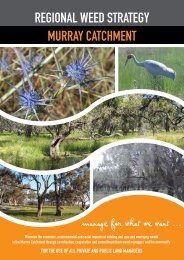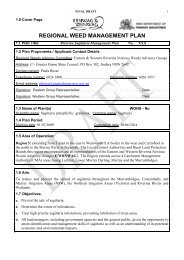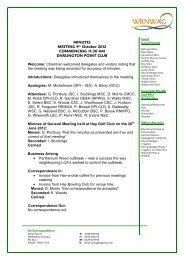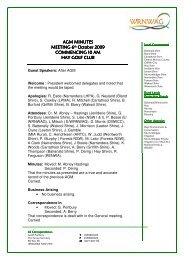Communication Strategy - Riverina Noxious Weeds Advisory Group
Communication Strategy - Riverina Noxious Weeds Advisory Group
Communication Strategy - Riverina Noxious Weeds Advisory Group
Create successful ePaper yourself
Turn your PDF publications into a flip-book with our unique Google optimized e-Paper software.
WAP 4.3.1<br />
NSW Invasive Species Plan. Goal 4: Capacity<br />
Ensure NSW has the ability and commitment<br />
to manage invasive species<br />
4.3 Increased community acceptance and<br />
involvement in effective weed management<br />
Regional Weed <strong>Strategy</strong>. Aim: Awareness, Education and Training<br />
Develop effective communication networks 3.1.1 Develop and implement a communication<br />
to disseminate information strategy<br />
The Eastern <strong>Riverina</strong> <strong>Noxious</strong> <strong>Weeds</strong> <strong>Advisory</strong> <strong>Group</strong> (ERNWAG) and Western <strong>Riverina</strong> <strong>Noxious</strong><br />
<strong>Weeds</strong> <strong>Advisory</strong> <strong>Group</strong> (WRNWAG) vision is to “Minimise the economic, environmental and social<br />
impacts of existing and new and emerging weeds in the Murray, Murrumbidgee and Lower Murray<br />
Darling Catchments through coordination, cooperation and commitment from weed managers and<br />
the community”.<br />
This strategy outlines the major communication, extension, training and education activities of<br />
ERNWAG & WRNWAG member organisations. The major activities and outcomes are taken directly<br />
from the <strong>Riverina</strong> WAP and 4 Regional Weed Strategies (RWS).<br />
Key messages as adopted from the Australian <strong>Weeds</strong> Committee <strong>Communication</strong>s <strong>Strategy</strong>:<br />
1. Weed management is an essential and integral part of the sustainable management of<br />
natural resources and the environment, and requires an integrated multi‐disciplinary<br />
approach.<br />
2. Prevention and early intervention are the most cost effective techniques that can be<br />
deployed against weeds.<br />
3. Successful weed management requires a coordinated approach which involves all levels of<br />
government in establishing appropriate legislative, educational and coordination<br />
frameworks in partnerships with industry, landholders and the community.<br />
4. The primary responsibility for weed management rests with landholders/land managers but<br />
collective action is necessary where the problem transcends the capacity of the individual<br />
landholder/land manager to address it adequately.<br />
NSW Invasive Species Plan 2008 ‐ 2015<br />
Lachlan<br />
RWS<br />
Lower Murray Darling<br />
Catchment RWS<br />
Murray Catchment<br />
RWS<br />
Murrumbidgee<br />
Catchment RWS<br />
<strong>Communication</strong> <strong>Strategy</strong><br />
<strong>Communication</strong> <strong>Strategy</strong> 17/06/2011 Page 1 of 3
Key stakeholders:<br />
State &<br />
Federal<br />
Government<br />
Media<br />
Bodies<br />
Ministers<br />
as<br />
applicable<br />
RNWPO<br />
Schools/<br />
Universities<br />
Nursery,<br />
Garden &<br />
Landscape<br />
Industry<br />
Relevant<br />
Cross<br />
Border<br />
Agencies<br />
DPI<br />
NSW<br />
ERNWAG &<br />
WRNWAG<br />
CMA’s<br />
ARTC<br />
RTA<br />
Landcare<br />
Networks<br />
LCA’s<br />
LHPA’s<br />
Office of<br />
Environment<br />
& Heritage<br />
Community<br />
<strong>Group</strong>s<br />
Land & Prop<br />
Management<br />
Authority<br />
Private<br />
Land<br />
Managers<br />
Irrigation<br />
Bodies<br />
Forests<br />
NSW<br />
<strong>Communication</strong> <strong>Strategy</strong> 17/06/2011 Page 2 of 3
Action Plan<br />
ERNWAG & WRNWAG Aims Code Activities<br />
Develop and implement<br />
regional weed control plans<br />
and strategies<br />
Promote the awareness of<br />
noxious and environmental<br />
weeds within the community.<br />
Education, train and<br />
encourage persons and<br />
organisations in all matters<br />
relating to noxious and<br />
environmental weeds<br />
Promote the coordination of<br />
weed management with all<br />
relevant stakeholders on a<br />
4.2 ISP<br />
4.3.2 WAP<br />
3.1.1 RWS<br />
4.3.2 WAP<br />
3.1.6 RWS<br />
Develop and implement communication<br />
campaigns that increase target audience<br />
awareness and understanding<br />
Circulate regular updates on the<br />
implementation of this strategy<br />
Develop weed management plans for priority<br />
weeds in consultation with stakeholders<br />
Who is<br />
responsible?<br />
All<br />
stakeholders<br />
All<br />
stakeholders<br />
4.2.1.6 WAP<br />
RNWPO,<br />
LCAs<br />
4.6.1 WAP Review existing plans and strategies RNWPO<br />
4.3.2.1 WAP<br />
Encourage use of existing weed awareness LCAs,<br />
programs (ie Weed Warriors) in local schools. RNWPO<br />
4.3.2.2 WAP<br />
Website updated monthly and on an as needs<br />
basis www.riverinaweeds.org.au<br />
RNWPO<br />
Promote state and national initiatives that<br />
4.3.2.3 WAP<br />
All<br />
raise the profile of weed management (weed<br />
3.2.2 RWS<br />
stakeholders<br />
buster week, WoNS, grow me instead)<br />
4.3.2.7 WAP<br />
4.3.2.11 WAP<br />
3.4.2 RWS<br />
4.3.2.12 WAP<br />
2.1.7. RWS<br />
4.3.2.10 WAP<br />
3.4.3 RWS<br />
4.3.2.5 WAP<br />
4.3.2.6 WAP<br />
4.3.2.8 WAP<br />
3.2.3 RWS<br />
4.3.2.9 WAP<br />
3.3.3 RWS<br />
4.3.2.4 WAP<br />
3.4.1 RWS<br />
Ensure NSW NS4W campaign is tied in with<br />
all regional activities<br />
Update Regional Weed Identification Guide<br />
(<strong>Weeds</strong> of the <strong>Riverina</strong>)<br />
Develop <strong>Weeds</strong> Information Pack including<br />
information on Category A <strong>Weeds</strong><br />
Distribute weed awareness resources on<br />
priority weeds (High Risk species)<br />
Identify and inform Weed Extension Team<br />
Leader of all current regional resources.<br />
Participate in Weed Awareness Plan<br />
reference group meetings/ correspondence<br />
Develop demonstration sites and run field<br />
days to educate land holders on best weed<br />
management practices for priority weeds<br />
Produce regular weed management material<br />
for the media and relevant publications<br />
regional basis 4.2 ISP Publicise weed management success stories<br />
Provide forum for the<br />
interchange of information<br />
4.3.2.13 WAP<br />
Attendance and participation at ERNWAG &<br />
WRNWAG meetings<br />
All<br />
stakeholders<br />
RNWPO<br />
LCAs<br />
RNWPO,<br />
LCAs, CMA<br />
RNWPO,<br />
LCAs<br />
RWACs, NSW<br />
DPI, LCAs<br />
LCAs, CMA,<br />
NSW DPI<br />
RNWPO,<br />
NSW DPI,<br />
LCAs<br />
LCAs,<br />
RNWPO<br />
All<br />
stakeholders<br />
Desired outcome:<br />
To have a well informed, well resourced, wide network of people involved in weed<br />
management<br />
Linkages<br />
• Lachlan RWS 2009 • Murray RWS 2008<br />
• Lower Murray Darling RWS 2006 • Murrumbidgee RWS 2007<br />
• NSW Invasive Species Plan 2008‐2015<br />
• <strong>Riverina</strong> (Lower Murray Darling, Lachlan, Murray & Murrumbidgee Catchments) WAP 2010‐2015<br />
<strong>Communication</strong> <strong>Strategy</strong> 17/06/2011 Page 3 of 3











